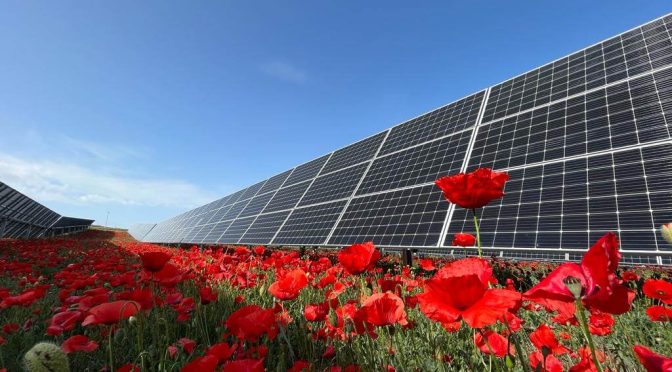As the world shifts its focus towards renewable energy, solar photovoltaics has become a clear pioneer in the global transition to a sustainable future. Faced with the threat of climate change, nations are struggling to reduce their carbon footprint and meet their energy demands in an environmentally friendly way. Photovoltaics, with its abundance and zero emissions, have become the preferred option for countries seeking to harness the power of nature.
The $250 billion global photovoltaic market is expected to experience unprecedented growth. Projections suggest it will exceed $400 billion by 2032, highlighting the growing investment and adoption of solar technologies around the world. This increase is driven by technological advances, supportive government policies, and growing public awareness of environmental issues.
Here are the top 10 PV generating countries exploring their solar capacity and growth prospects.
China – 584 TWh
China leads the global photovoltaic revolution, producing 584 terawatt-hours (TWh) of electricity from solar energy. With the largest installed capacity of solar photovoltaic (PV) panels worldwide, Chinese companies dominate the list of top 10 solar panel manufacturers. These companies export their products particularly to regions such as Europe and North America. China’s success in photovoltaics is driven by massive investments, aggressive legislation and technological advances. Supportive policies and government subsidies create an enabling environment for growth and innovation.
USA – 238 TWh
Benefiting from abundant sunlight and favourable regulations, the United States leads in solar energy production. With vast land masses receiving sunlight for most of the day, the country generates approximately 90 gigawatt-hours of electricity. States like California, Arizona, and Texas drive this growth, witnessing substantial solar project expansions. Technological advancements and reasonable costs have spurred solar energy adoption nationwide. The federal government incentivizes solar projects through subsidies like the Investment Tax Credit and net metering. These initiatives promote sustainability and reduce reliance on traditional fossil fuels.
India – 113 TWh
India capitalises on its abundant solar resources, situated advantageously in the torrid zone, ensuring consistent sunlight exposure year-round. Pioneering off-grid solar solutions for rural areas, the country showcases its commitment to socio-economic advancement through advanced solar technology.
To drive solar energy adoption, the Indian government has implemented various supportive schemes and policies. These initiatives facilitate the establishment of solar power systems and firms, with subsidised manufacturing costs for solar panels, promoting accessibility and affordability.
Japan – 110 TWh
The Fukushima nuclear disaster in 2011 prompted Japan to shift towards solar energy to meet its energy needs. Japan now generates 110 TWh of electricity from solar power. Leading Japanese manufacturers and exporters of photovoltaics, such as Kyocera, Mitsubishi Electric, Mitsubishi Heavy Industries, Sanyo, Sharp Solar, Solar Frontier, and Toshiba, play a crucial role in this transition. They promote and encourage rooftop solar panel installations, contributing significantly to Japan’s solar energy production.
Germany – 62 TWh
Germany, focusing on decentralised energy production, has significantly enhanced its solar energy output, generating 62 TWh despite limited sunlight availability. Germany’s commitment to optimising solar energy serves as a global example.
The government supports this sector by offering subsidies, tax exemptions, and favourable tariffs, encouraging investors to fund solar projects.
Brazil – 52 TWh
Brazil is a leader in renewable energy in South America, benefiting from excellent solar radiation levels due to its favourable latitude. The country has harnessed this potential to advance its solar energy production. Government initiatives, such as net metering, promoting renewable energy and stabilising the carbon footprint are factors that are helping Brazil’s growing solar energy generation. Net metering allows customers to receive credits on their bills by selling excess electricity back to the grid, further encouraging the adoption of solar energy.
Australia – 47 TWh
Australia’s commitment to renewable energy has driven significant progress in solar power. The country’s vast landscape and remote communities have led to the development of off-grid solar energy projects.
Government initiatives like the Large-scale Renewable Energy Target (LRET) mandate a certain percentage of electricity from renewable sources. Additionally, the Clean Energy Finance Corporation (CEFC) provides financing for renewable energy projects. These measures have propelled Australia’s solar energy production and supported its transition towards sustainable energy.
Spain – 45 TWh
Spain was an early leader in large-scale solar photovoltaics and concentrated solar power (CSP) production. Initially, the country played a crucial role in developing solar power, offering generous prices for grid-connected solar power to boost the industry. This led to a rapid but unsustainable boom, placing Spain second only to Germany in installed solar capacity.However, the 2008 financial crisis prompted the Spanish government to cut subsidies drastically and cap capacity increases at 500 MW per year, affecting the industry globally. Between 2012 and 2016, new installations stagnated in Spain while other countries like Germany, China, and Japan surged ahead, causing Spain to lose its leading status in solar power.
Italy – 31 TWh
Italy’s commitment to clean energy has driven significant growth in solar energy production. The country’s strong determination to shift toward renewable energy and address climate change has been influential in Europe’s broader green energy goals. Feed-in tariffs and net metering schemes have encouraged the deployment of solar PV systems across residential and commercial sectors, supporting Italy’s transition to sustainable energy sources.
South Korea – 29 TWh
South Korea is the tenth-highest producing nation of solar energy in the world because of its superior R&D and technological capabilities. The nation’s solar energy industry has grown steadily thanks to large expenditures made in the production, installation, and use of PV. South Korea’s position in the global solar energy industry has been strengthened by government incentives such as the Renewable Portfolio Standard and solar feed-in tariffs, which have stimulated the development of solar power plants across numerous sectors.

